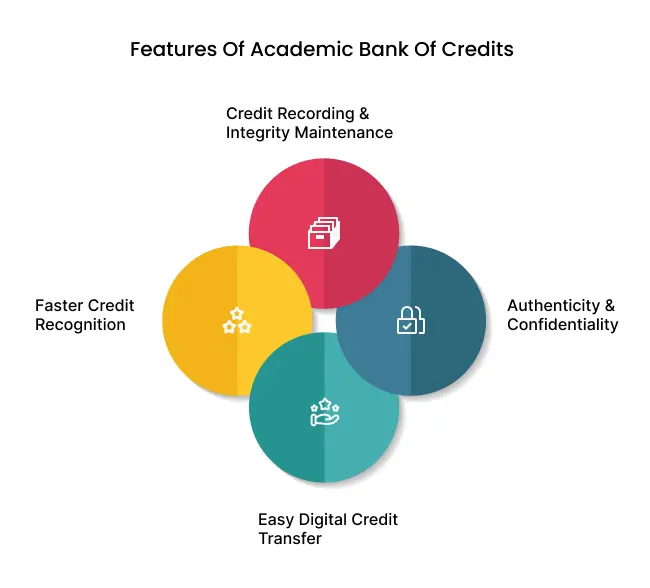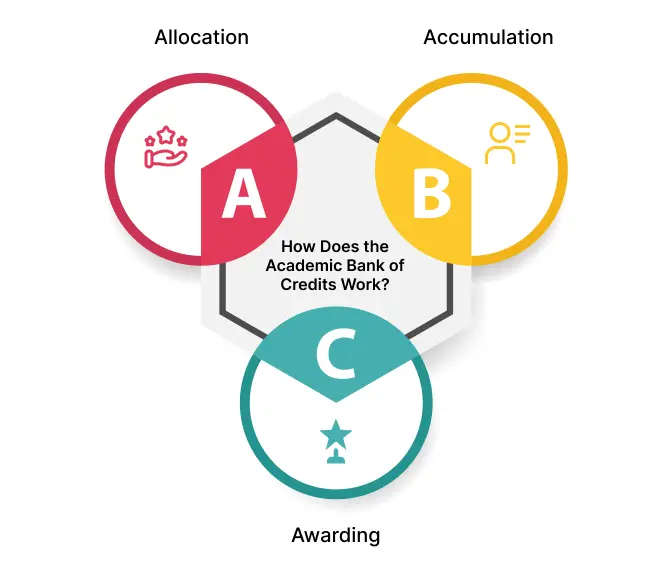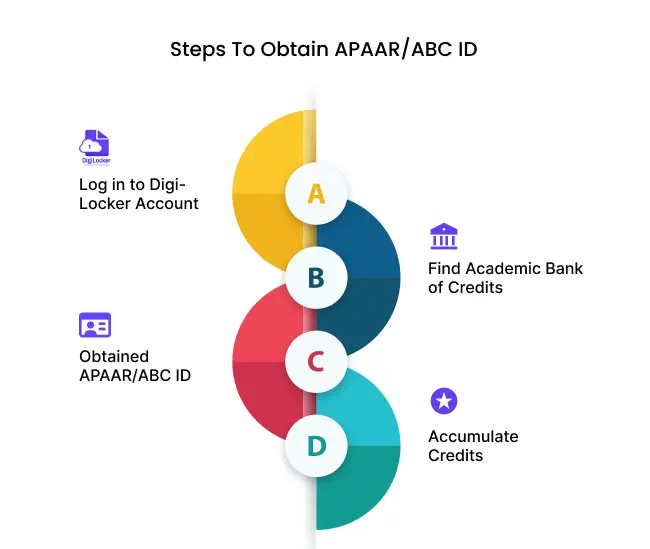Introduction
For every person out there who is working, achieving, and earning, Banks have become a very necessary place. Not only does it safekeep the money that an individual earns, but with modern technology, the money can be easily used or transferred anywhere digitally.
But what if the same concept can be used in education to help and recognize every student’s hard work and educational achievement?
The government of India understood this vision and with UGC and NEP 2020 initiated the Academic Bank of Credit (ABC). Just like students obtain marks after exams, they will also obtain certain credits after completing a course or earning a degree. These credits are proof of students' academic achievements and can be used as educational currency.
Confused? Let's read more about the Academic Bank of Credits, how it works, and most importantly how beneficial it is for students' educational journey.
Table Of Contents
- What is the Academic Bank of Credits?
- Features of Academic Bank of Credits
- Benefits of Academic Bank of Credits
- How Does the Academic Bank of Credits Work?
- How can students access the benefits of the Academic Bank of Credit?
- Steps to Obtain APAAR/ABC ID
- Significance of APAAR
What is the Academic Bank of Credits?
Academic Banks of Credits is a central digital storage system where the credits earned by students after completing a course or program are accumulated, stored, and transferred or redeemed when needed. ABC helps in the recognition of a student's academic achievements and makes student mobility across different institutes or courses easier.
Aligning with the University Grant Commission (UGC) and National Education Policy 2020 (NEP 2020), the Academic Bank of Credits was launched by Prime Minister Narendra Modi on July 29, 2021. It was launched as a part of the one-year anniversary of National Education Policy 2020 (NEP 2020). The idea was to create a system similar to the monetary banking system, except instead of money, the bank would hold credits earned by students.
This approach can prove to boost students' morale as they feel a sense of recognition for their efforts. Think of it from a student's perspective: if every educational achievement earns you credits that reflect your learning prowess, your drive to do better academically surely gets a boost.

Features of Academic Bank of Credits
The features of ABC are very similar to that of a bank. For better understanding, I suggest you think of credits as educational currency and then read the features below.
1. Credit Recording & Integrity Maintenance
Simply as the heading suggests with the Academic Bank of Credits, educational institutions maintain a secure and accurate record of credits for every student. Institutions upload every student’s credits, ensuring that their credits are accurately recorded and preserved within the system.
2. Authenticity & Confidentiality
Just like banks must ensure the authenticity and confidentiality of the money of account holders, ABC uses advanced technology to maintain the authenticity and confidentiality of students' credits. All the credit stored in the Academic Bank of Credits is authenticated and verified by accredited institutions to make sure that the data is trustworthy and accurate. ABC also provides high security against data breaches and leaks.
3. Easy Digital Credit Transfer
Similar to digital money transfers and payments of a bank, Academic Bank of Credits enables easy and smooth credit transfer. Through a fully digital platform, students can easily transfer their credits between institutions. This feature supports greater student mobility and flexibility in education.
4. Faster Credit Recognition
Academic Banks of Credits also assist in faster recognition of students' credits. This makes it easier for educational institutes to quickly verify, validate, and accept credits transferred from other institutions. This is a perfect feature that lets students continue their education without unnecessary interruption or administrative hurdles. With these features working together, Academic Bank of grades and answers. The flexibility, transparency, and efficiency of the Indian education system.
Benefits of Academic Bank of Credits
As we can clearly see the visions behind this initiative and its impressive practical features, it is evident that ABC is highly beneficial to students and institutions alike. Allow me to take you through its impressive benefits.
1. Multiple Entry And Exit Points
Those times are gone when, due to personal or professional reasons, students have to quit and later restart their educational course or program from scratch. Academic Banks of Credits let students enter and exit their academic programs at various stages. This is to grant them flexibility to take breaks or change their academic paths without worrying about losing their hard-earned credits.
2. Credit Shelf Life
The credits in ABC will be preserved and stored for a maximum duration of seven years. The time frame has been carefully thought out to ensure that the knowledge and skills of students remain relevant and give students appropriate time to complete their education.
3. Single Window Credit Transfer
Academic Bank of Credits makes transactions and transfers of credits a breeze. It allows credit transfer, validation, and recognition through one single window system. After approval from both the source and destination, the credits are transferred, ensuring that the transfer is valid and the receiving institution recognizes the credits.
4. Verified Educational Institutions
ABC also has security provisions to ensure that only verified educational institutions can upload credits to the ABC account of students. This is important to make sure that the credits are recognized and accredited by institutions.
5. Transparency And Flexibility In Curriculum Design
Academic Bank of Credits also improves this transparency in the education system by providing clear records of academic credits. Besides this, ABC also offers flexibility in curriculum design and development. This allows institutions to offer diverse and interdisciplinary courses. With the benefits we just covered, it can be clearly said that ABC does not only benefit students but institutions as well. Another thing that you should know about ABC is how it works.
How Does the Academic Bank of Credits Work?
Academic Bank of Credits is carefully designed to make managing and transferring academy credits to different institutions an easy process. The complete working of ABC revolves around three key processes or the 3 A’s — Allocation, Accumulation, and Awarding.

1.Allocation Of Credits
Each academic institution that participates in the ABC system provides credits to students based on their completed courses, projects, or any academic achievement. These credits are then allocated to the student’s ABC account, which can be used for future educational purposes.
2. Accumulation Of Credits
The credits earned by students are then accumulated and preserved in the student’s ABC account. The accumulated credits are represented in the form of a digital transcript, making it easier for students and institutions to view their educational progress and achievements. The accumulation also enables students to easily transfer their credits between different academic institutions.
3. Awarding Of Credits
The final stage of the working of ABC is the awarding of credits. Once the required number of credits is accumulated and recognized, they are awarded to students for obtaining a diploma, degree, or certificate. This makes students’ academic achievements tangible and recognized nationwide, further enhancing their academic portfolio.
How can students access the benefits of the Academic Bank of Credit?
To reap the benefits of ABC, all the student needs is an ABC account and a 12-digit APAAR/ABC ID.
This ID links to the ABC account, which stores credits that reflect the educational achievements of students and facilitates the transferring and redeeming of credits. All the features and benefits we discussed throughout the block can be accessed through this account.

Steps to Obtain APAAR/ABC ID
Here is the procedure that students must follow in order to open an Academic Bank of Credit Account and obtain the APAAR:
1. Log in to Digi-Locker Account
Students first need to log into their Digi-Locker account. Digi-Locker is a digital platform provided by the government of India for storing and accessing official documents online. It's secure, easy to use, and facilitates easy access to educational records, including those related to the Academic Bank of Credits.
2. Find Academic Bank of Credits
In the “Search Document” section of Digi-Locker, find the Academic Bank of Credits. Click on 'Register' and complete the registration process by providing the necessary details. This step connects your educational achievements to the central system of ABC, enabling the accumulation and use of academic credits.
3. Obtained APAAR/ABC ID
Once the registration is done, download the document PDF from Digi-Locker, where you will find your APAAR/ABC ID. This ID serves as your unique identifier within the Academic Bank of Credits system, allowing you to track and manage your accumulated credits seamlessly.
4. Accumulate Credits
This APAAR/ABC ID is to be shared with respective institutions to record academic credits in their account. Institutions use this ID to upload and verify your academic achievements, making the credits available in your ABC account. This allows you to accumulate credits over time, which can be redeemed for certifications, diplomas, or degrees.
There you go, registering for ABC and availing of the benefits is as simple as that! Now, you have a comprehensive understanding of the Academic Bank of Credits. Before we conclude this article, one more thing that you must be aware of is...
Significance of APAAR
APAAR Stands for Automated Permanent Academic Account Registry.
It helps in gathering and safekeeping academic achievements for students. With APAAR students can transfer between institutions easily for further education.
In a nutshell, APAAR ID simplifies the process of recognizing and transferring credits, starting from schools. It helps in maintaining smooth academic progress and recognition of prior learning.
Conclusion
With all we have covered in this article, it can be clearly stated that the Academic Bank of Credits is a visionary initiative by the Government of India that will completely reform the education system. Aligning with NEP 2020, ABC responds to the needs of today's learners. The more ABC is embraced by students and institutions, the more it will shape an inclusive and efficient education system.
The success of the Academic Bank of Credits will depend on the collaborative efforts of students and institutions to ensure its effective implementation and continuous improvement.




